www.willhiteweb.com - Hiking, Climbing and Travel
Old Irontown
Old Iron Town, originally Iron City, is a ghost town in Iron County, about 22 miles from Cedar City. The settlement was founded in 1868 as a second attempt to mine iron from Iron Mountain after a disappointing yield from Cedar City. The colony lasted until 1876, when strife from the Edmunds Tucker Act and Panic of 1873 forced its closure. The site was added to the National Register of Historic Places in 1971.
Brigham Young realized that the fastest way to an independent Mormon state was to make the new colony self-sufficient. One important resource in this regard was iron, which was very expensive to ship from the eastern United States. The city of Parowan was founded in 1851 to provide iron for the settlers, which was mined in nearby Iron Mission (Cedar City). Only 400 short tons of iron were produced over a six-year period.
Iron was nonetheless needed for continued prosperity, so a second attempt at mining the region was made in 1868. The newly formed Union Iron Works organized an establishment at the southern base of Iron Mountain on Pinto Creek, west of Cedar City. By the third year, over 2,500 pounds of iron were produced every day. The company expanded in 1873 and continued to mine ore for three more years. At its peak, the settlement included a schoolhouse, blacksmith, charcoal furnaces, and a foundry. The city was abandoned in 1876. An attempt was made to revive mining from Iron Mountain, but the church was struggling with litigation over the Edmunds Tucker Act and the Panic of 1873.
Today, the ruins feature a preserved beehive style charcoal oven and a furnace known as an "Arastra", which prepared sands for molds. Parts of the original foundry remain, including the chimney. The site was fenced off by the Sons of Utah Pioneers. It is currently within grounds designated as the Dixie National Forest. The Frontier Homestead State Park Museum in Cedar City provides information about and artifacts from the site. The ruins are found on Iron Town Road, which intersects with Utah State Route 56. It was added to the National Register of Historic Places on May 14, 1971 as Old Iron Town.
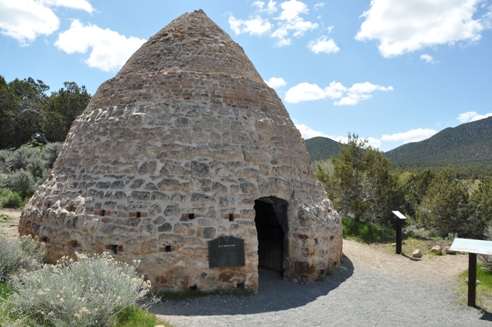
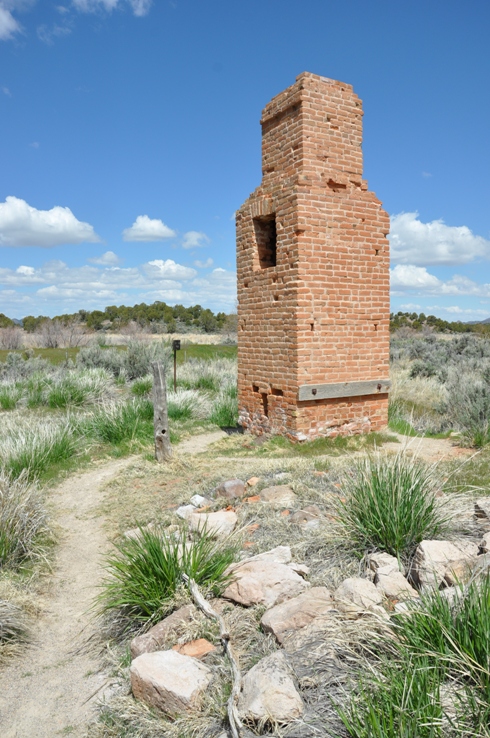
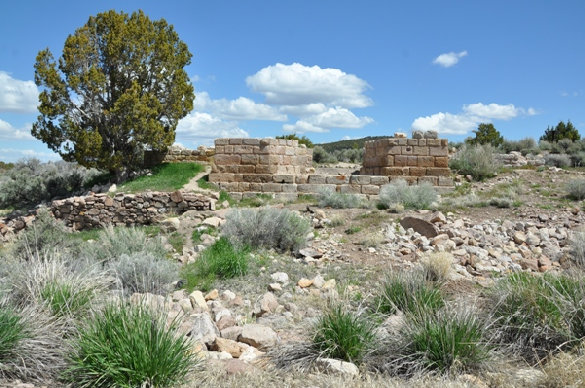
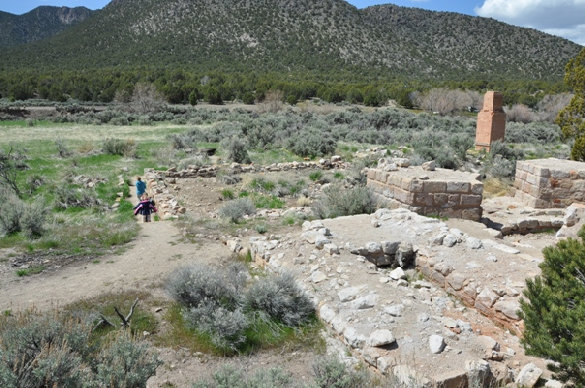
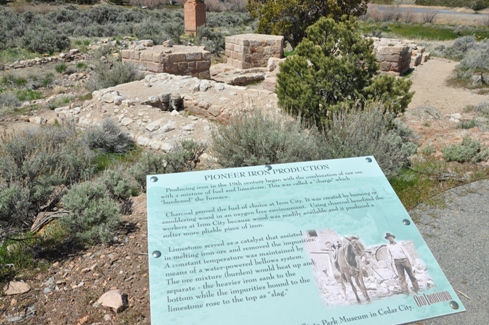
Charcoal was the fuel of choice for the iron works at Iron City. Charcoal is created by burning or smoldering wood in a reduced oxygen environment. Workers would stack piles of juniper and pinyon inside the beehive shaped kilns and light a fire underneath. The holes you see in the far wall could be plugged or opened as needed to increase or decrease air circulation. It took approximately 12 days for one kiln to produce 50 bushels of charcoal. This would provide enough fuel to process one ton of iron ore. Iron City originally had two kilns - however, due to the destructive power of weather and looters only this one remains.
The Charcoal Kiln
Iron mining was not profitable in Iron County, until the Columbia Steel Corporation built a blast furnace at Irontown, near Provo, Utah.
With the demand for iron ore rising, Union Pacific, in 1923, agreed to construct a spur line. The new rail line would pass through Lund, Iron Springs, and into Cedar City. Iron ore would no longer be processed locally - it would be shipped to Northern Utah by rail, sending over 500 tons per day.
The mining process involved the use of open pit blasting. By 1960 foreign competition and domestic tax issues resulted in a reduction of the overall tonnage. These detrimental factors only worsened and by the mid-1980s all iron mining operations had stopped. This area still holds one of the nations richest iron ore deposits.
Producing iron in the 19th century began with the combination of raw ore with a mixture of fuel and limestone. This was called a "charge" which "burdened" the furnace.
Charcoal proved the fuel of choice at Iron City. It was created by burning or smoldering wood in an oxygen free environment. Using charcoal benefited the workers at Iron City because wood was readily available and it produced a softer more pliable piece of iron.
Limestone served as a catalyst that assisted in melting iron ore and removed the impurities. A constant temperature was maintained by means of a water-powered bellows system. The ore mixture (burden) would heat up and separate - the heavier iron sank to the bottom while the impurities bound to the limestone rose to the top as "slag."
Pioneer Iron Production
The Mining Boom
Original foundry chimney
Although discovered by Peter Shirts in early 1868 - the area known as Iron City blossomed under the investment of Ebenezer Hanks. In June of 1868 Hanks established the Union Iron Company, later known as the Great Western Iron Company.
The 1870 census indicates that 97 people, living in 19 households resided in Iron City. The iron works consisted of a furnace, with a 2,500-pound capacity, a pattern shop, molding shop, erastra, (grinding device) and two charcoal kilns.
The Great Western Iron Company needed large sums of capitol to operate, and outside investors were sought. With new money came new labor. Many of these workers were not members of the conservative religion and Iron City soon became a place where drinking and swearing were commonplace. By 1871 Iron City had a post office, boarding house, a brick schoolhouse, butcher shop, and a general store.
At peak production the iron works produced 5-7 tons of pig iron per day. They supplied ore for the Utah Western Railroad, mining companies in Pioche, Nevada, and also provided the iron used in the 12 oxen that support the St. George LDS Temple baptismal font.
The Great Western Iron Company could not survive financially selling small items to cash - strapped Mormon settlers and could no longer afford the shipping costs for their larger contracts. The iron works closed in 1876.
Now known as Old Irontown State Park, this area has been preserved for its distinctive structures and historical presence.
Old Irontown
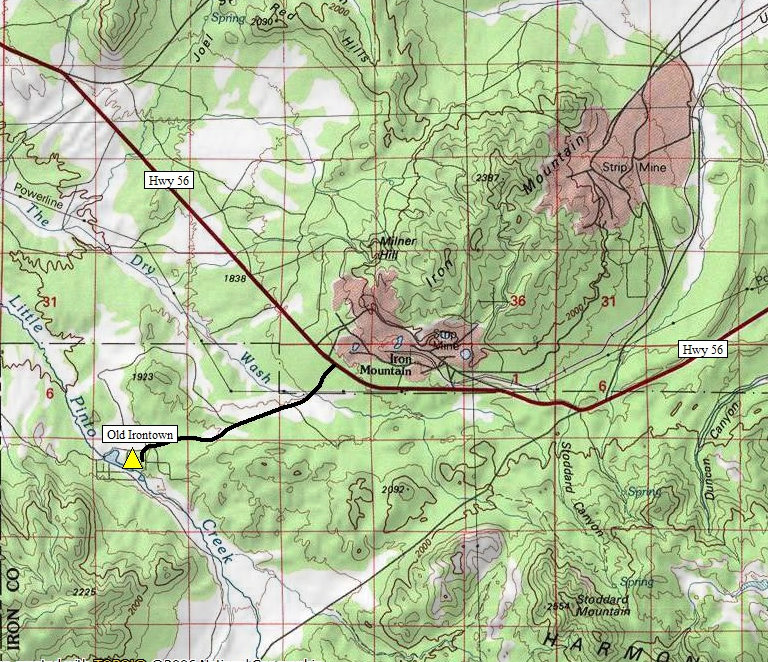
<





